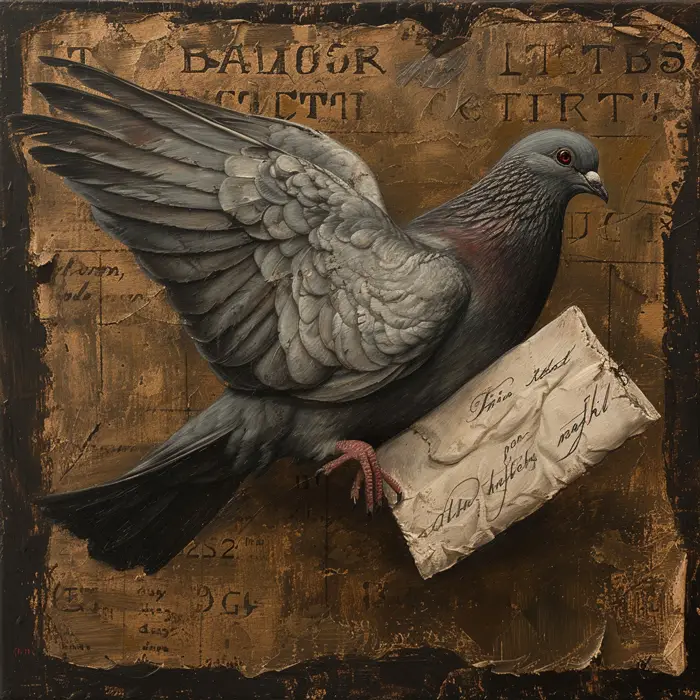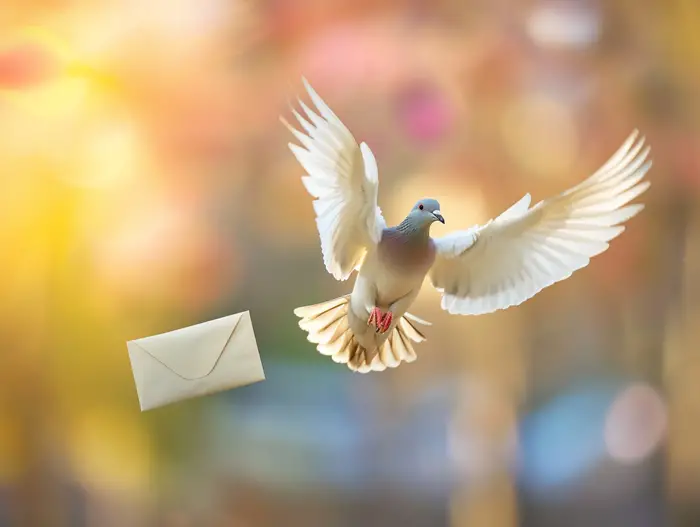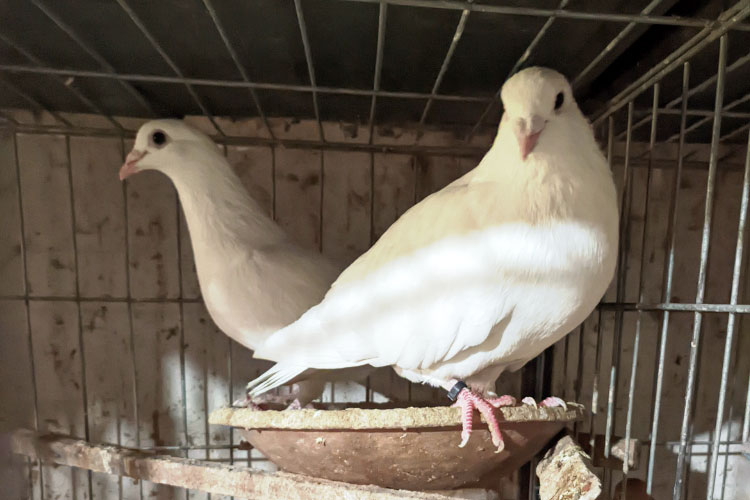Carrier Pigeon Communication: A Historical Recap
Carrier pigeon communication has a fascinating history that spans centuries and continents. These remarkable birds have played a crucial role in human communication, delivering messages across vast distances with remarkable speed and accuracy. From ancient civilizations to modern warfare, carrier pigeons have been trusted messengers, carrying vital information in times of peace and conflict.
Throughout history, carrier pigeons have been hailed as the ultimate form of communication technology. Their ability to navigate long distances and find their way back home is nothing short of remarkable. Whether it was delivering messages during wartime or aiding in scientific experiments, carrier pigeons have proven themselves to be invaluable allies in human communication.
In this article, I’ll delve into the captivating history of carrier pigeon communication, exploring their origins, their role in various cultures, and their remarkable feats of navigation and endurance. Join me as we uncover the fascinating stories and achievements of these feathered messengers that have left an indelible mark on the pages of history.
The Origins of Carrier Pigeon Communication
Carrier pigeon communication has a long and fascinating history, stretching back thousands of years. In ancient times, people used pigeons to send messages across vast distances, before modern forms of communication, such as telegraphs and cell phones, were invented. Let’s take a closer look at the origins of carrier pigeon communication and how these remarkable birds came to play such an important role in human history.

Ancient Mesopotamia and Egypt
The use of carrier pigeons can be traced back to ancient Mesopotamia, around 2000 BCE. It is believed that the Mesopotamians were the first to recognize the remarkable navigational abilities of pigeons and began using them to deliver messages. The practice then spread to ancient Egypt, where carrier pigeons became an integral part of their communication system.
Greece and Rome
Carrier pigeon communication continued to develop and gained popularity in ancient Greece and Rome. The Greeks used pigeons to convey the results of the Olympic Games, while the Romans used them to deliver news of important events, such as the outcome of battles. These pigeons were known as “homing pigeons” due to their incredible ability to find their way back home, even over long distances.
Middle Ages and Beyond
During the Middle Ages, carrier pigeons played a crucial role in military communication. Knights and generals used them to send messages from the battlefield to their commanders, allowing for swift communication and strategic coordination. Carrier pigeons were also used by merchants to send business-related messages, further enhancing the spread of information across regions.
Scientific Experiments and World Wars
Carrier pigeons continued to be utilized in various capacities throughout history. In the 19th and early 20th centuries, they were a popular subject for scientific experiments, helping researchers study animal navigation and migration. They also played an integral role in both World War I and World War II, with thousands of carrier pigeons carrying vital messages between military units and across enemy lines.
Carrier pigeon communication has left an indelible mark on our history, allowing for communication over vast distances. These birds, with their exceptional navigational abilities, have proven themselves to be reliable messengers throughout the centuries. From ancient civilizations to modern warfare, carrier pigeons have played a vital role in human communication, leaving a lasting legacy that continues to fascinate us today.
Carrier Pigeons in Ancient Civilizations
Carrier pigeons, fascinating creatures that they are, have a long and storied history that dates back to ancient civilizations. In this section, I’ll explore how carrier pigeons played a significant role in communication during the ancient times.

Originating in Mesopotamia and Egypt
The ancient Mesopotamians and Egyptians were pioneers in using carrier pigeons for long-distance communication. Before the advent of modern means of communication, such as telegraphs and phones, carrier pigeons proved to be a reliable method to convey important messages across great distances. These civilizations recognized the extraordinary navigation abilities of carrier pigeons, which made them perfect for communication purposes.
Spreading to Ancient Greece and Rome
From Mesopotamia and Egypt, the practice of using carrier pigeons spread to ancient Greece and Rome. Both civilizations found immense value in these winged messengers. Carrier pigeons were utilized to deliver vital messages from one city-state to another in ancient Greece. They were also utilized by the Romans for military communication and to send important messages across their vast empire.
Middle Ages and Beyond
During the Middle Ages, carrier pigeons continued to play a crucial role in communication, particularly in military operations. Armies relied on carrier pigeons to send quick and secure messages on the battlefield. Additionally, carrier pigeons were also employed by merchants to transmit business-related information, ensuring timely communication between trading partners.
Scientific Experiments and Historical Wars
Carrier pigeons further proved their worth in the 19th and early 20th centuries through scientific experiments and historical wars. Researchers conducted various experiments to study these birds’ navigational abilities, marveling at their uncanny homing instincts. In World War I and World War II, carrier pigeons became indispensable tools for military communication, saving countless lives by delivering time-sensitive messages in challenging conditions.
The use of carrier pigeon communication in ancient civilizations laid the foundation for its continued importance throughout history. Their exceptional navigational abilities and reliability made them the ideal messengers for long-distance communication. As we move forward in the article, we’ll explore how carrier pigeons made an impact in different aspects of society and war, leaving a lasting legacy behind.
Carrier Pigeons in Warfare
During the Middle Ages, carrier pigeons played an essential role in military communication. Their ability to carry messages across long distances made them a valuable asset on the battlefield. In this section, I will explore how carrier pigeons were used in warfare and why they were so effective.
Messenger pigeons were extensively used for communication between military units. They were trained to fly back to their home base with vital information, such as troop movements, enemy positions, and tactical plans. The reliability and speed of carrier pigeons made them an invaluable tool for conveying urgent messages.

One of the reasons carrier pigeons were so effective in warfare was their remarkable navigational abilities. They could fly over rough terrains and navigate through unfamiliar territories, always finding their way back to their destination. This made them incredibly reliable in situations where traditional messengers might get lost or intercepted.
To ensure the success of carrier pigeon communication in warfare, several measures were taken. Pigeon lofts were strategically placed in different locations to maximize coverage and minimize delivery time. These lofts provided a safe and familiar place for the pigeons to return to after their missions.
Message capsules were used to carry the written messages securely. These capsules were lightweight and attached to the bird’s leg for safe transport. Once the pigeon reached its destination, the capsule would be retrieved, and the message would be delivered promptly.
Carrier pigeons played a crucial role in various historical wars, including both World War I and World War II. They were used by different nations to transmit important information and coordinate military operations. The speed and efficiency of carrier pigeon communication was unmatched during this era, making them an indispensable asset on the battlefield.
Carrier pigeons had a significant impact on warfare during the Middle Ages and beyond. Their reliable communication capabilities, remarkable navigational skills, and swift delivery of messages made them an essential tool for military operations. The incredible feats achieved by these pigeons in transmitting information in difficult and dangerous circumstances are truly commendable.
Scientific Experiments and Carrier Pigeons
During the historical period of carrier pigeon communication, scientific experiments were conducted to better understand and utilize these remarkable birds. Researchers were amazed by the abilities of carrier pigeons and sought to uncover the secrets behind their extraordinary navigational skills and swift delivery of messages.
One such experiment involved testing the homing instinct of carrier pigeons. Scientists would transport pigeons to a distant location and release them to observe their ability to find their way back home. It was discovered that carrier pigeons possess an innate sense of direction, allowing them to navigate long distances with incredible accuracy. This trait made them ideal messengers, as they could reliably return to their home loft even from unfamiliar territories.
In addition to their sense of direction, carrier pigeons were found to possess an impressive memory. Researchers conducted experiments where pigeons were trained to associate certain locations with rewards, such as food or treats. The pigeons quickly learned to associate these locations with positive outcomes and would repeatedly return to them. This demonstrated their ability to remember specific landmarks and use them to navigate their way back home.

Another notable experiment explored the physical capabilities of carrier pigeons. Researchers measured the birds’ speed and endurance, discovering that carrier pigeons could travel at impressive speeds of up to 60 miles per hour and cover hundreds of miles in a single flight. This made them invaluable messengers for military operations, as they could swiftly deliver vital information, surpassing the limitations of other communication methods of the time.
Overall, these scientific experiments helped to shed light on the remarkable abilities of carrier pigeons and how they could be effectively utilized in communication. Their innate sense of direction, exceptional memory, and impressive physical capabilities made them an essential tool for military operations. These experiments not only enhanced our understanding of carrier pigeons but also further emphasized their historical significance in warfare.
- Carrier pigeons possess an innate sense of direction, allowing them to navigate long distances accurately.
- Pigeons have an impressive memory and can remember specific landmarks to find their way back home.
- Carrier pigeons can travel at speeds of up to 60 miles per hour, making them incredibly efficient messengers.
| Key Statistics |
|---|
| Pigeon Speed: Up to 60 miles per hour |
| Distance Covered: Hundreds of miles in one flight |
The Enduring Legacy of Carrier Pigeons
Carrier pigeons have left an enduring legacy throughout history. Their remarkable communication abilities and navigational skills made them indispensable in various military operations. Let’s delve into the lasting impact of these incredible creatures.
1. Vital Role in Warfare
Carrier pigeons played a crucial role in warfare, particularly during the Middle Ages and both World Wars. Their unmatched speed and efficiency in delivering messages made them a valuable asset on the battlefield. These feathered messengers carried vital information, including troop movements and tactical plans, back to their home base, ensuring the smooth coordination of military operations.
2. Reliable Communication Tool
One of the key reasons carrier pigeons were relied upon was their consistent and reliable communication capabilities. They were able to deliver messages even in challenging environments, where traditional messengers might get lost or intercepted. The use of pigeon lofts strategically placed to maximize coverage and minimize delivery time further enhanced their efficiency.
3. Impressive Navigational Abilities
Scientific experiments conducted on carrier pigeons revealed their innate sense of direction and incredible memory. These birds could navigate over great distances, often returning to their original location with remarkable accuracy. Their ability to find their way home, even from unfamiliar territory, was nothing short of astounding.
4. Swift Delivery Speeds
Carrier pigeons were renowned for their exceptional speed. These avian messengers could travel at impressive speeds of up to 60 miles per hour, ensuring that urgent information reached its destination quickly and efficiently. This swiftness was crucial in the fast-paced environment of warfare, where time was of the essence.
5. Cultural Significance
Beyond their military role, carrier pigeons also hold cultural significance. They have been celebrated in literature, art, and popular culture, symbolizing resilience, determination, and effective communication. Their unwavering commitment to delivering messages has captured the imagination of people throughout history.
The enduring legacy of carrier pigeons is a testament to their remarkable communication skills and navigational abilities. These avian messengers were vital tools in warfare, offering reliable and swift delivery of information. Their cultural significance further adds to their enduring reputation. The impact of carrier pigeons on military operations and their symbolic importance make them a fascinating part of history.
Conclusion
Carrier pigeon communication has played a crucial role in the history of warfare, providing a reliable and efficient means of transmitting vital information. These remarkable birds possessed navigational abilities that made them invaluable messengers, especially in situations where traditional methods of communication were not feasible. Their speed and efficiency in delivering messages made them essential tools in military operations.
The strategic placement of pigeon lofts and the use of message capsules ensured secure and timely delivery of written messages. Carrier pigeons were able to travel at impressive speeds of up to 60 miles per hour, making them unmatched in their ability to swiftly relay information.
Scientific experiments conducted to understand carrier pigeons revealed their innate sense of direction, impressive memory, and their ability to navigate through challenging terrains. These experiments further emphasized the historical significance of carrier pigeons in warfare.
The enduring legacy of carrier pigeons is a testament to their remarkable communication skills and navigational abilities. Their impact on military operations and their symbolic importance make them a fascinating part of history. The cultural significance of carrier pigeons further adds to their enduring reputation as avian messengers.
Carrier pigeons have left an indelible mark on the history of communication and warfare, showcasing their unmatched speed, reliability, and efficiency. Their legacy will continue to be remembered and appreciated as a remarkable chapter in the annals of human ingenuity.






